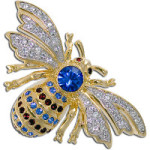Gemstones: Miraculous and Mysterious

Gemstones are all different. A gemstone is a mineral rock or petrified material that when cut or faceted and polished can be used in jewelry or is a collectible. Others are organic. Some are too fragile to be used in jewelry, but can be seen on display in museums. The most important attribute of gemstones is their appearance.
Things to consider when shopping for gemstones are color, clarity, cut, size, rarity, durability and fashion.
Diamonds, rubies, sapphires, emeralds, and amethysts have been commonly considered “precious” stones.
“Semi precious” stones are valued for their beauty, but are not one of the five “precious” stones. Some examples of semi precious stones are, aventurine, carnelian, garnet, opal, peridot, rose quartz, aquamarine, tanzanite, citrine, topaz, tourmaline etc.
Synthetic gemstones are made in a laboratory. Synthetic stones have very similar physical and visual properties as natural gemstones but are recreated above ground in a laboratory.
Gems are sometimes treated to improve their appearance or durability, or even change their color. Jewelers should tell you whether a gemstone(s) has been treated since sometimes the treatment is not permanent, or the stone may require special care or the treatment could significantly affect the value of the gemstone. Some think gemstones have healing powers.

Bumble Bee
Brooch
Is costume jewelry a good investment?
Costume jewelry, bijoux fantaisies in French, is affordable jewelry that can complete an outfit. It is designed for wearing with current fashions and usually made of inexpensive materials. Today modern costume jewelry incorporates a wide range of materials allowing designers to create jewelry that is unique and beautiful.
Politically Correct Diamonds “Lab Diamonds”
Now the environment in which a diamond naturally grows can be recreated above ground in a laboratory. The results are gem-quality stones the same as natural diamonds called lab diamonds. These diamonds are being graded by the GIA (Gemological Institute of America) like natural diamonds using the 3 “C’s: color, clarity, and cut.
